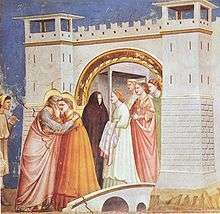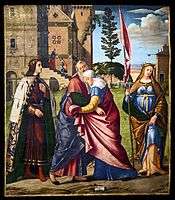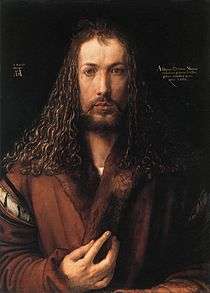Joachim and Anne Meeting at the Golden Gate


Joachim and Anne Meeting at the Golden Gate is a 1504 woodcut by the German artist Albrecht Dürer that depicts the standard scene of the parents of the Virgin Mary, Joachim and Anne meeting at the Golden Gate of Jerusalem, upon learning that she will bear a child.
The story of the Meeting at the Golden Gate is not in the New Testament, but is in the Protoevangelium of James and other apocryphal accounts; however it was tolerated by the Church. It featured in the medieval Golden Legend and other popular accounts. The print shows an embracing couple beneath an ornamental archway, surrounded by neighbours and fools.
The work is one of 16 woodcuts and prints in Dürer's Life of the Virgin series, which he executed between 1501 and 1511. Joachim and Anne Meeting at the Golden Gate is the only work in the series to include a date.[1] Throughout the series, the Virgin is displayed as an intermediary between the divine and the earth, yet shown with a range of human frailties. The full series of prints was first published in 1511. Printed on the reverse of each was a Latin text written by a member of his intellectual circle in Nuremberg, the Benedictine Abbot Benedictus Chelidonius.[2]
Dürer's version
Benedictus Chelidonius' work describes the story of the married couple Joachim and Anne, who, though they were devoted to each other, were deeply unhappy as they were childless, which they took as a sign that they must have been rejected by God. An angel informs Anne of her conception, while at the same time asking her to meet her husband at the city gate in Jerusalem. On meeting, the couple entwine in joy. According to Chelidonius: "Overjoyed Anne threw herself into the arms of her husband; together they rejoiced about the honour that was to be granted them in the form of a child. For they knew from the heavenly messenger that the child would be a Queen, powerful on heaven and on earth".[3] In traditional depictions of the occasion, the pair embrace, but don't kiss.[4]
Dürer here follows an early Renaissance convention involving the illusion of looking through an open window. He framed many of his works in this way, including Joachim and Anne Meeting at the Golden Gate, which is outlined by a Renaissance arch.[5] The artist's mix of classical and sixteenth-century Nuremberg motifs, as well as the northern European setting, were utilised to bring the images closer to the audience. According to the critic Laurie Meunier Graves, "these prints manage to illuminate the sacred while at the same time providing scenes of homely, Renaissance life. They are a beautiful blend of the holy and the secular. In addition, woodcuts are an art form that gives plenty of latitude to the imagination and leaves room for fancy."[6] As with the other works in the series, it is distinguished by virtuoso use of line and highly skilled cutting.[7]
The scene in art
The church had developed the doctrine that the Virgin Mary was, uniquely, born without original sin; this is known as the doctrine of the Immaculate Conception (which refers to the conception of Mary, not that of Jesus). In the Middle Ages the doctrine remained controversial, opposed by St Thomas Aquinas and his Dominican Order, but supported by the Franciscan Order. It was not formally established as doctrine until 1854, in the First Vatican Council.[8]
This scene represented the conception of Mary, and was an early scene in the many cycles of the Life of the Virgin, the counterpart of the Annunciation showing the conception of Jesus. To some medieval viewers, the kiss was a literal representation of the moment of Mary's conception, while for others it was a symbolic representation. The main figures may be accompanied, usually Anne with women and Joachim with shepherds. The Archangel Gabriel, always shown in Annunciations, may appear here also.[9] Sometimes other saints are included.
The 14th and 15th centuries were the heyday of depictions. Gradually more allegorical depictions of the Immaculate Conception, featuring an adult Mary, replaced this scene in representing the doctrine.[10]
 Russian icon, perhaps before 1169
Russian icon, perhaps before 1169 Giotto di Bondone, Legend of St Joachim, Meeting at the Golden Gate, 1305, is an early Western depiction of the scene.
Giotto di Bondone, Legend of St Joachim, Meeting at the Golden Gate, 1305, is an early Western depiction of the scene. Master of the Golden Gate, late 14th century
Master of the Golden Gate, late 14th century
 Eugenio Cajés, 1605; by now the scene was becoming less frequent
Eugenio Cajés, 1605; by now the scene was becoming less frequent
Notes
- ↑ Willi (1935), p. 25.
- ↑ "Albrecht Durer (Nuremberg, 1471–1528): The Engraved Passion". Spaightwood Galleries. Retrieved on 18 October 2007.
- ↑ Nurnberg (1983), Ilus. 59.
- ↑ Lubbock, Tom. "The Meeting at the Golden Gate (1305)". The Independent (UK), 16 February 2007. Retrieved on 14 October 2007.
- ↑ Shaw-Eagle, Joanna. "Four Exhibits Drawn Together". The Washington Times, 29 July 2000.
- ↑ Meunier Graves, Laurie. "Dürer's life of the Virgin as social document Archived 2008-05-12 at the Wayback Machine.". Retrieved on 18 October 2007.
- ↑ "The Life of the Virgin Archived 2007-11-29 at the Wayback Machine.". "German 16th Century Prints". Victoria: Art Gallery of Greater Victoria, 1983. Retrieved on 18 October 2007.
- ↑ Hall, 326
- ↑ Hall, 170-171
- ↑ Hall, 171
Sources
- Hall, James, Hall's Dictionary of Subjects and Symbols in Art, 1996 (2nd edn.), John Murray, ISBN 0719541476
- Kurth, Dr. Willi. "The complete woodcuts of Albrecht Durer". New York: Arden Book Co, 1935.
- Nurnberg, Verlag Hans Carl. "Dürer in Dublin: Engravings and woodcuts of Albrecht Dürer". Chester Beatty Libraery, 1983.
- Strauss, Walter L. "Albrecht Durer Woodcuts and Woodblocks". The Burlington Magazine, Vol. 124, No. 955, October, 1982. pp. 638–639.
External links
| Wikimedia Commons has media related to Albrecht Dürer woodcut series – Life of the Virgin. |
| Wikimedia Commons has media related to Meeting at the Golden Gate. |
